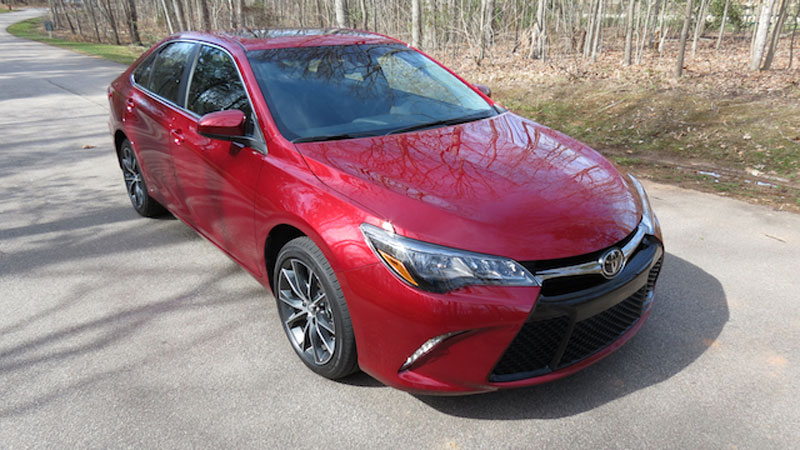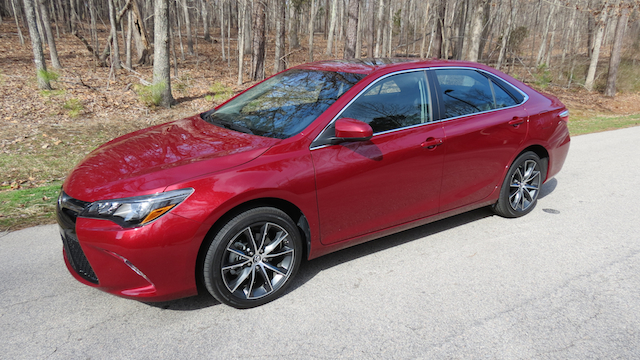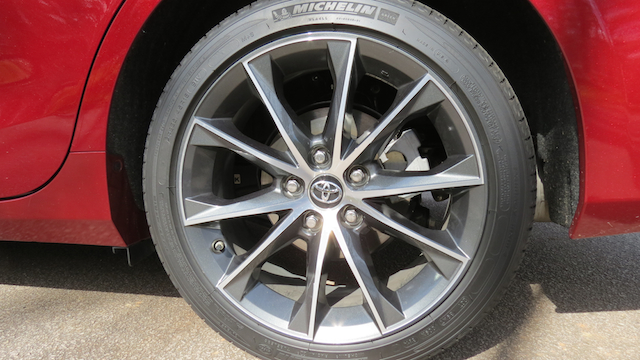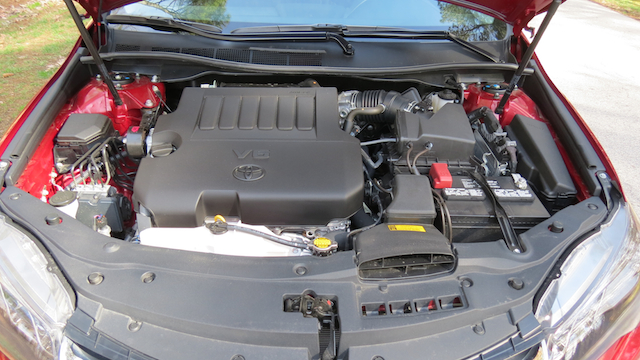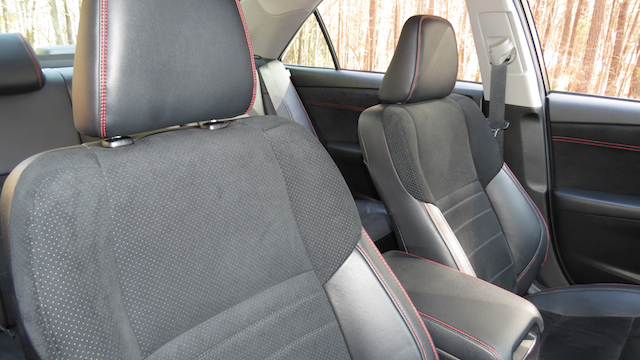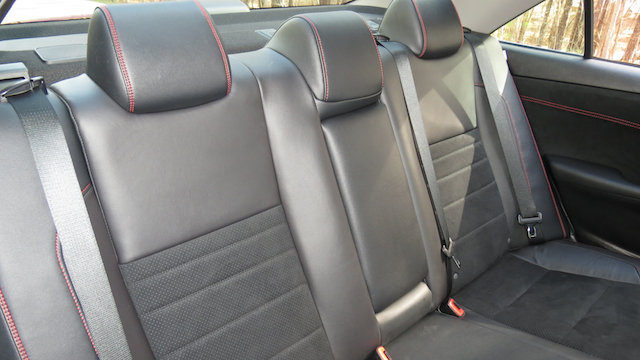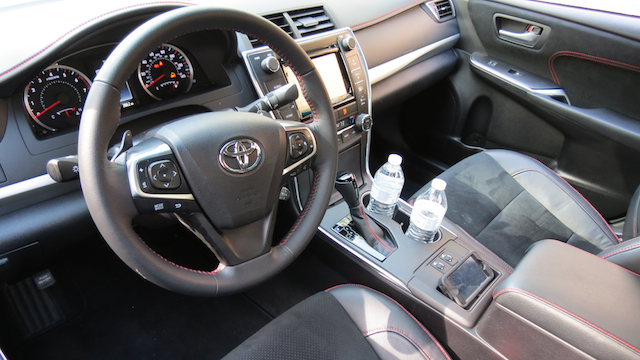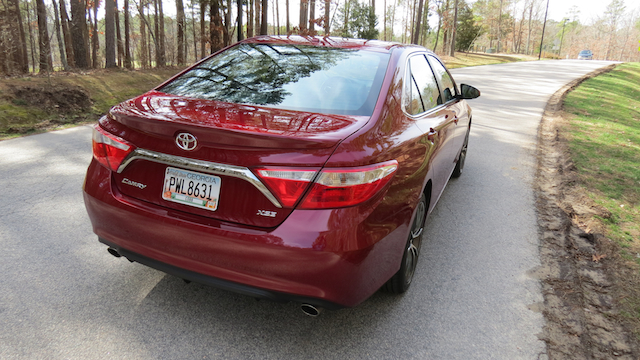America’s best selling car model holds tight to its lead. A V-6 option adds performance, although it lacks the handling characteristics of a sports sedan. The 2015 Toyota Camry has an appealing visage and offers a model for a variety of shoppers, including an available hybrid edition.
Back in the 1990s, Toyota marketed its midsize sedan as the “Family Camry.” The automaker featured spots about people who owned not just one, not two, but usually three or four of these models, passing older copies to their children when they reached driving age.
A number of those older models had high mileage, but seemed new, attesting to the sedan’s durability. Or so it went.
That marketing plan may have helped Toyota move to the top rung amongst passenger cars, a position it has held nearly every year this millennium. And just when Toyota seems as if they may lose ground to arch-rivals such as the Honda Accord, Nissan Altima and the Ford Fusion, the company introduces a new model.
2015 Toyota Camry
Indeed, the current iteration made its debut in 2012, marking the start of the seventh generation of this five-passenger, front-wheel-drive sedan.
And to ensure that it holds the top spot for at least the short term, Toyota rushed a mid-cycle refresh to the market just two years later to counter updates made to some of its chief competitors. Never fear, the Toyota Camry has tightened its lock on the top spot and seems assured to hold on until the next generation model appears, probably in 2018.
It is true that some people hate the Camry and probably a host of other Toyota products. Much of that antipathy has to do with austere styling, something Toyota has been moving away from in recent years.
Granted, the haters aren’t likely to be impressed by the Camry’s reliability and high residual values — they want newfangled styling above all else.
Flair and Distinction Added
Well, the current Camry has a certain flair to it that was not available previously. Indeed, Toyota now incorporates its own version of the Lexus spindle grille with a distinctive front fascia featuring a piano black grille, wraparound headlamps and crescent LED daytime running lights set within deep grooves.
It is a more daring design, something you would expect to find in a Ford Fusion or a Hyundai Sonata.
From front to back the current Camry has an athletic stance punctuated by wrap around tail lamps and LED lights to the rear and dual exhaust ports. Looks wise, this sedan is a significant improvement over the previous generation model and the choice of colors and wheels simply enhances that vibe.
What has not changed for the Toyota Camry is its powertrain offerings. Yes, in recent years the manual transmission was dropped and the automatic transmission now has six forward gears. But the 2.5-liter four-cylinder engine making 178-horsepower returns as well as the optional 3.5-liter V-6 rated at 268 horsepower.
V-6 With Torque Steer
The four-cylinder engine is standard across the model line and is the only engine available in the LE and SE editions. Both the XLE and the XSE provide a V-6 option, a $5,200 upgrade that brings in a host of other features. My test model was a 2015 Toyota Camry XSE with the V-6 engine.
I have driven Toyotas equipped with either the four-cylinder or the V-6, and can say that there is a world of difference between the two. That Toyota continues to offer a V-6 in a segment that is largely dominated by naturally-aspirated and turbocharged in-line four-cylinder engines is important to note.
That this same engine is rated at 21 mpg in the city and 31 mpg on the highway may appeal to people who place an emphasis on performance, but still want good fuel economy.
When you start the V-6 Camry and shift the transmission into gear — hold on tight. Torque steer (understeer) is evident with the front wheels wanting to shift to the left or to the right as copious amounts of power is suddenly delivered.
Certainly, if torque vectoring control is present, I didn’t sense it — I knew that a sudden press on the accelerator would cause the tires to squeal, signaling me to tighten my grip on the steering wheel.
Once you are on the road, you can shift the transmission into manual mode and work the stick or the paddle shifters. That is, if clutchless shifting is your desire. In the Camry, you don’t operate the paddles, rather the buttons located on the back of the steering wheel adjacent to those paddles.
Initially, I sensed that the paddles were disconnected as I pressed on each one — I finally figured out that there were buttons present and made my adjustment.
If you have a need for speed, the V-6 Camry will not disappoint. In fact, be prepared to travel from 0 to 60 mph in just under six seconds. The sport suspension ups the handling quotient, but steering seems sluggish with little feedback. As for the “sport” in sport suspension, let’s just say that Toyota hardly strayed from the comfort mode there.
Cabin by Lexus?
Inside, its seems as if Lexus’ designers were all over the cabin. The Camry XSE is dressed in black leather with red stitching across the seats, around the steering wheel, on door inlays, across the dashboard and on the center console.
The seats are supportive and I incurred no fatigue, even following hours of driving. Between the 8-way power adjustment and lumbar support as well as the tilt and telescoping steering wheel column, you can find the ideal driving position.
The rest of the cabin is covered in soft touch materials, aluminum trim and wherever plastic is used it is of the hardened variety. That’s what you obtain in a Camry priced in the mid-30s. Yes, at that price point you may begin to look at the rear-wheel drive Lexus IS. If you do, go with the larger V-6 and you won’t be disappointed. Just saying.
If you are a rear seated passenger in the 2015 Toyota Camry, be encouraged: there is ample room for three adults. Then again, the 60-40 split-folding bench seat offers a tempting middle armrest that provides the requisite two cup holders. Here, you might want to convince one passenger to ride with elsewhere.
Standard across the Camry line is air conditioning, power accessories, Bluetooth connectivity, an illuminated glove box, an overhead console with sunglasses holder, two 12-volt auxiliary power outlets, four cup holders and four in-door drink holders.
The XSE V-6 edition upgrades the instrument panel, adds in the sporty front seats, and also provides an automatic dimming rearview mirror, a Homeline transceiver, and dual-zone climate control.
The Toyota Camry offers a fairly soft ride, but interior noise is average — I kept hearing wind noise intruding — it seemed to come in at the front of the driver and front passenger windows.
Thankfully, Toyota’s Entune infotainment system is one of the preferable ones on the market. You can sync your phone, access the available App Suite and plug-in navigation commands without much drama.
As tested, the Camry XSE has several upgrades that enhance the ownership experience, including remote start ($499), a technology package with lane departure warning and dynamic radar cruise control ($750), an upgraded Entune audio package with JBL audio ($805), blind spot monitor ($500) and illuminated door sills ($299). Special floor mats ($325) and a unique paint finish ($395) were also included.
Toyota Camry Considerations
Although the latest iteration of the Toyota Camry offers a styling improvement, likely the sedan won’t conquest sport sedan drivers from different brands. Instead, it should keep loyal Camry owners in the fold, especially those who may have been looking at competing eye candy and were considering making the jump.
Besides improving the handling, there are two changes on my Camry wish list, both not likely to be adopted any time soon. First, let’s stick a turbocharged engine under the hood.
Toyota Motors has been a laggard in that department, but now has a 2.0-liter twin-scroll turbo powering the all-new Lexus NX. Second, an all-wheel drive variant would be ideal — the Subaru Legacy is all-wheel drive only; the Ford Fusion and Chrysler 200 offer that option.
To sum up, I believe that a turbo has a much greater chance of appearing down the road, but all-wheel drive isn’t likely. After all, when people are already pleased with the product you deliver, certain engineering changes and options are not likely to bring in the additional customers.
|
Photos copyright Auto Trends Magazine. All rights reserved.
- 2024 Mazda CX-50: A Compact SUV with Premium Aspirations - Apr 15, 2024
- 2024 Ford Mustang (Iconic Pony Car Evolves) - Apr 4, 2024
- 2024 Ford Maverick (Looks Like a Truck, Drives Like a Car) - Mar 28, 2024

